1、等到spring的refresh方法到registerBeanPostProcessors

protected void registerBeanPostProcessors(ConfigurableListableBeanFactory beanFactory) {
PostProcessorRegistrationDelegate.registerBeanPostProcessors(beanFactory, this);
}
跟之前的BeanProcessorFactory注册的流程一样
public static void registerBeanPostProcessors(
ConfigurableListableBeanFactory beanFactory, AbstractApplicationContext applicationContext) {
String[] postProcessorNames = beanFactory.getBeanNamesForType(BeanPostProcessor.class, true, false);
// Register BeanPostProcessorChecker that logs an info message when
// a bean is created during BeanPostProcessor instantiation, i.e. when
// a bean is not eligible for getting processed by all BeanPostProcessors.
int beanProcessorTargetCount = beanFactory.getBeanPostProcessorCount() + 1 + postProcessorNames.length;
beanFactory.addBeanPostProcessor(new BeanPostProcessorChecker(beanFactory, beanProcessorTargetCount));
// Separate between BeanPostProcessors that implement PriorityOrdered,
// Ordered, and the rest.
List<BeanPostProcessor> priorityOrderedPostProcessors = new ArrayList<BeanPostProcessor>();
List<BeanPostProcessor> internalPostProcessors = new ArrayList<BeanPostProcessor>();
List<String> orderedPostProcessorNames = new ArrayList<String>();
List<String> nonOrderedPostProcessorNames = new ArrayList<String>();
for (String ppName : postProcessorNames) {
if (beanFactory.isTypeMatch(ppName, PriorityOrdered.class)) {
BeanPostProcessor pp = beanFactory.getBean(ppName, BeanPostProcessor.class);
priorityOrderedPostProcessors.add(pp);
if (pp instanceof MergedBeanDefinitionPostProcessor) {
internalPostProcessors.add(pp);
}
}
else if (beanFactory.isTypeMatch(ppName, Ordered.class)) {
orderedPostProcessorNames.add(ppName);
}
else {
nonOrderedPostProcessorNames.add(ppName);
}
}
// First, register the BeanPostProcessors that implement PriorityOrdered.
sortPostProcessors(beanFactory, priorityOrderedPostProcessors);
registerBeanPostProcessors(beanFactory, priorityOrderedPostProcessors);
// Next, register the BeanPostProcessors that implement Ordered.
List<BeanPostProcessor> orderedPostProcessors = new ArrayList<BeanPostProcessor>();
for (String ppName : orderedPostProcessorNames) {
BeanPostProcessor pp = beanFactory.getBean(ppName, BeanPostProcessor.class);
orderedPostProcessors.add(pp);
if (pp instanceof MergedBeanDefinitionPostProcessor) {
internalPostProcessors.add(pp);
}
}
sortPostProcessors(beanFactory, orderedPostProcessors);
registerBeanPostProcessors(beanFactory, orderedPostProcessors);
// Now, register all regular BeanPostProcessors.
List<BeanPostProcessor> nonOrderedPostProcessors = new ArrayList<BeanPostProcessor>();
for (String ppName : nonOrderedPostProcessorNames) {
BeanPostProcessor pp = beanFactory.getBean(ppName, BeanPostProcessor.class);
nonOrderedPostProcessors.add(pp);
if (pp instanceof MergedBeanDefinitionPostProcessor) {
internalPostProcessors.add(pp);
}
}
registerBeanPostProcessors(beanFactory, nonOrderedPostProcessors);
// Finally, re-register all internal BeanPostProcessors.
sortPostProcessors(beanFactory, internalPostProcessors);
registerBeanPostProcessors(beanFactory, internalPostProcessors);
beanFactory.addBeanPostProcessor(new ApplicationListenerDetector(applicationContext));
}
2、等到BeanProcessor初始化完成后执行initMessageSource
protected void initMessageSource() {
//此处得到的是DefaultListBeanFactory
ConfigurableListableBeanFactory beanFactory = getBeanFactory();
//DefaultListBeanFactory是没有创建messageSource
if (beanFactory.containsLocalBean(MESSAGE_SOURCE_BEAN_NAME)) {
this.messageSource = beanFactory.getBean(MESSAGE_SOURCE_BEAN_NAME, MessageSource.class);
// Make MessageSource aware of parent MessageSource.
if (this.parent != null && this.messageSource instanceof HierarchicalMessageSource) {
HierarchicalMessageSource hms = (HierarchicalMessageSource) this.messageSource;
if (hms.getParentMessageSource() == null) {
// Only set parent context as parent MessageSource if no parent MessageSource
// registered already.
hms.setParentMessageSource(getInternalParentMessageSource());
}
}
if (logger.isDebugEnabled()) {
logger.debug("Using MessageSource [" + this.messageSource + "]");
}
}
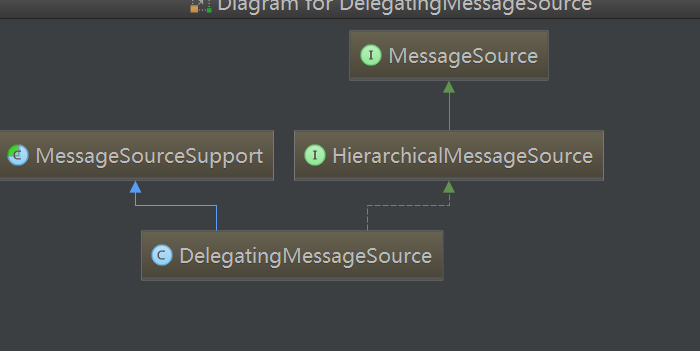 // 此时走创建实体类
else {
// Use empty MessageSource to be able to accept getMessage calls.
DelegatingMessageSource dms = new DelegatingMessageSource();
dms.setParentMessageSource(getInternalParentMessageSource());
this.messageSource = dms;
//注册messageRource
registerSingleton(MESSAGE_SOURCE_BEAN_NAME, this.messageSource);
// 此时走创建实体类
else {
// Use empty MessageSource to be able to accept getMessage calls.
DelegatingMessageSource dms = new DelegatingMessageSource();
dms.setParentMessageSource(getInternalParentMessageSource());
this.messageSource = dms;
//注册messageRource
registerSingleton(MESSAGE_SOURCE_BEAN_NAME, this.messageSource);
public void registerSingleton(String beanName, Object singletonObject) throws IllegalStateException {
super.registerSingleton(beanName, singletonObject);
if (hasBeanCreationStarted()) {
// Cannot modify startup-time collection elements anymore (for stable iteration)
synchronized (this.beanDefinitionMap) {
if (!this.beanDefinitionMap.containsKey(beanName)) {
Set<String> updatedSingletons = new LinkedHashSet<String>(this.manualSingletonNames.size() + 1);
updatedSingletons.addAll(this.manualSingletonNames);
updatedSingletons.add(beanName);
this.manualSingletonNames = updatedSingletons;
}
}
}
else {
// Still in startup registration phase
if (!this.beanDefinitionMap.containsKey(beanName)) {
this.manualSingletonNames.add(beanName);
}
}
clearByTypeCache();
}
if (logger.isDebugEnabled()) {
logger.debug("Unable to locate MessageSource with name '" + MESSAGE_SOURCE_BEAN_NAME +
"': using default [" + this.messageSource + "]");
}
}
}
至此次MessageResource类初始化完成
3、初始化ApplicationEventMulticaster子类(这个类及子类是监听器的管理类,负责各种ApplicationListener的事件发布等)
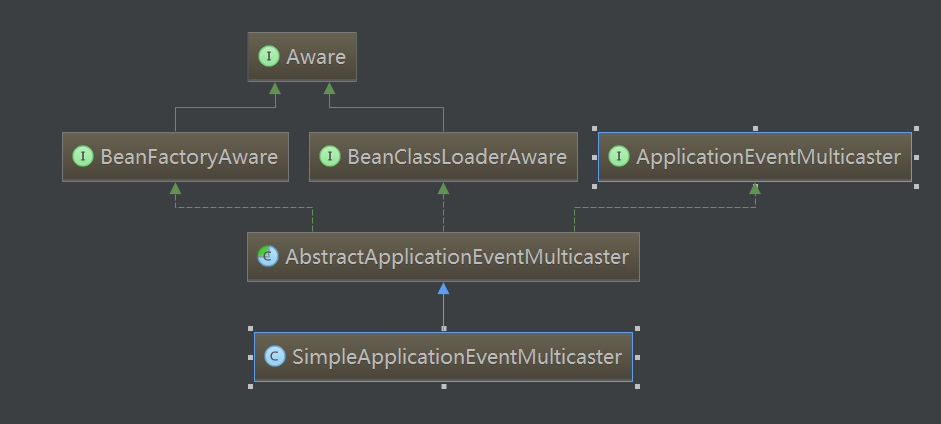
protected void initApplicationEventMulticaster() {
ConfigurableListableBeanFactory beanFactory = getBeanFactory();
//各种判断是否包含在已有的bean集合中
public boolean containsLocalBean(String name) {
String beanName = transformedBeanName(name);
return ((containsSingleton(beanName) || containsBeanDefinition(beanName)) &&
(!BeanFactoryUtils.isFactoryDereference(name) || isFactoryBean(beanName)));
}
if (beanFactory.containsLocalBean(APPLICATION_EVENT_MULTICASTER_BEAN_NAME)) {
this.applicationEventMulticaster =
beanFactory.getBean(APPLICATION_EVENT_MULTICASTER_BEAN_NAME, ApplicationEventMulticaster.class);
if (logger.isDebugEnabled()) {
logger.debug("Using ApplicationEventMulticaster [" + this.applicationEventMulticaster + "]");
}
}
else {
//没有则创建一个
this.applicationEventMulticaster = new SimpleApplicationEventMulticaster(beanFactory);
//注册到beanFactory
beanFactory.registerSingleton(APPLICATION_EVENT_MULTICASTER_BEAN_NAME, this.applicationEventMulticaster);
if (logger.isDebugEnabled()) {
logger.debug("Unable to locate ApplicationEventMulticaster with name '" +
APPLICATION_EVENT_MULTICASTER_BEAN_NAME +
"': using default [" + this.applicationEventMulticaster + "]");
}
}
}
4、onRefresh 方法:
protected void onRefresh() {
this.themeSource = UiApplicationContextUtils.initThemeSource(this);
}
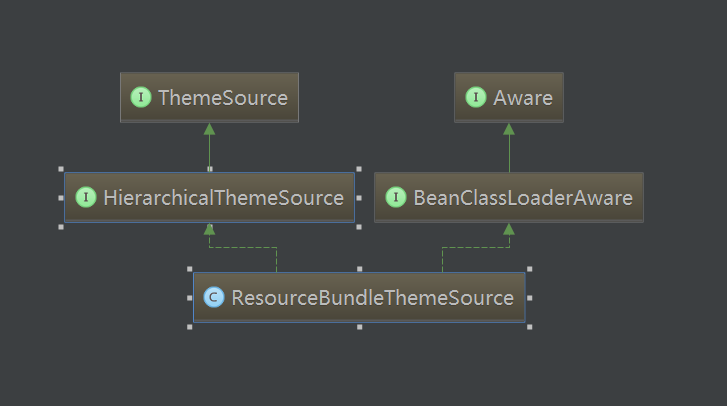
public static ThemeSource initThemeSource(ApplicationContext context) {
if (context.containsLocalBean(THEME_SOURCE_BEAN_NAME)) {
ThemeSource themeSource = context.getBean(THEME_SOURCE_BEAN_NAME, ThemeSource.class);
// Make ThemeSource aware of parent ThemeSource.
if (context.getParent() instanceof ThemeSource && themeSource instanceof HierarchicalThemeSource) {
HierarchicalThemeSource hts = (HierarchicalThemeSource) themeSource;
if (hts.getParentThemeSource() == null) {
// Only set parent context as parent ThemeSource if no parent ThemeSource
// registered already.
hts.setParentThemeSource((ThemeSource) context.getParent());
}
}
if (logger.isDebugEnabled()) {
logger.debug("Using ThemeSource [" + themeSource + "]");
}
return themeSource;
}
else {
// Use default ThemeSource to be able to accept getTheme calls, either
// delegating to parent context's default or to local ResourceBundleThemeSource.
HierarchicalThemeSource themeSource = null;
if (context.getParent() instanceof ThemeSource) {
themeSource = new DelegatingThemeSource();
themeSource.setParentThemeSource((ThemeSource) context.getParent());
}
else {
//没有就新建一个ThemeSource
themeSource = new ResourceBundleThemeSource();
}
if (logger.isDebugEnabled()) {
logger.debug("Unable to locate ThemeSource with name '" + THEME_SOURCE_BEAN_NAME +
"': using default [" + themeSource + "]");
}
return themeSource;
}
}
}
就是设置了一个ThemeSource对象。。。onRefresh方法
5、registerListeners 方法
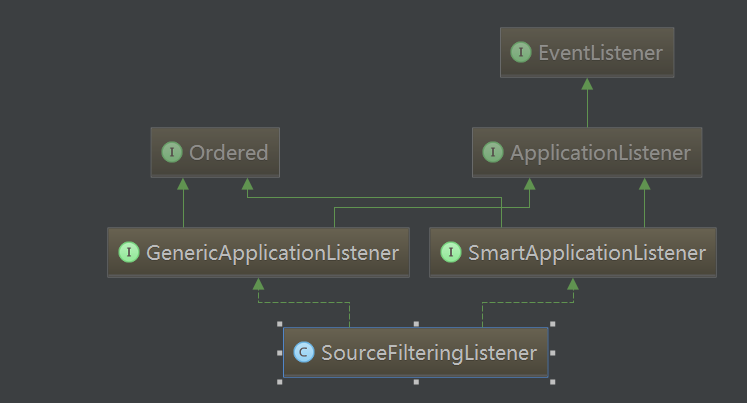
public Collection<ApplicationListener<?>> getApplicationListeners() {
return this.applicationListeners;
}
protected void registerListeners() {
// Register statically specified listeners first.
//获取工程中实例化的监听器
for (ApplicationListener<?> listener : getApplicationListeners()) {
//获取ApplicationEventMulticaster对象然后通过它管理ApplicationListener,即添加,删除,发布事件等,对于事件来说专业点就是多路广播,土话就是遍历持有的list,发布所以的ApplicationListener事件
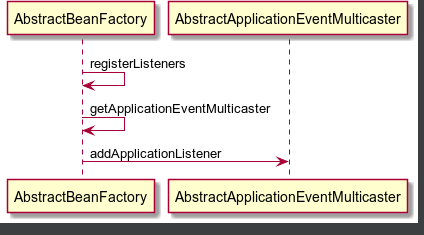 getApplicationEventMulticaster().addApplicationListener(listener);
}
// Do not initialize FactoryBeans here: We need to leave all regular beans
// uninitialized to let post-processors apply to them!
//获取到工厂内所有ApplicationListener类型的实例名称逐一实例化及调用DefaultListBeanFactory的getBeanManesForType
String[] listenerBeanNames = getBeanNamesForType(ApplicationListener.class, true, false);
for (String listenerBeanName : listenerBeanNames) {
getApplicationEventMulticaster().addApplicationListenerBean(listenerBeanName);
}
// Publish early application events now that we finally have a multicaster...
Set<ApplicationEvent> earlyEventsToProcess = this.earlyApplicationEvents;
this.earlyApplicationEvents = null;
if (earlyEventsToProcess != null) {
for (ApplicationEvent earlyEvent : earlyEventsToProcess) {
getApplicationEventMulticaster().multicastEvent(earlyEvent);
}
}
}
getApplicationEventMulticaster().addApplicationListener(listener);
}
// Do not initialize FactoryBeans here: We need to leave all regular beans
// uninitialized to let post-processors apply to them!
//获取到工厂内所有ApplicationListener类型的实例名称逐一实例化及调用DefaultListBeanFactory的getBeanManesForType
String[] listenerBeanNames = getBeanNamesForType(ApplicationListener.class, true, false);
for (String listenerBeanName : listenerBeanNames) {
getApplicationEventMulticaster().addApplicationListenerBean(listenerBeanName);
}
// Publish early application events now that we finally have a multicaster...
Set<ApplicationEvent> earlyEventsToProcess = this.earlyApplicationEvents;
this.earlyApplicationEvents = null;
if (earlyEventsToProcess != null) {
for (ApplicationEvent earlyEvent : earlyEventsToProcess) {
getApplicationEventMulticaster().multicastEvent(earlyEvent);
}
}
}
6、finishBeanFactoryInitialization方法初始剩余没有初始的工作
protected void finishBeanFactoryInitialization(ConfigurableListableBeanFactory beanFactory) {
// Initialize conversion service for this context.
if (beanFactory.containsBean(CONVERSION_SERVICE_BEAN_NAME) &&
beanFactory.isTypeMatch(CONVERSION_SERVICE_BEAN_NAME, ConversionService.class)) {
beanFactory.setConversionService(
beanFactory.getBean(CONVERSION_SERVICE_BEAN_NAME, ConversionService.class));
}
// Initialize LoadTimeWeaverAware beans early to allow for registering their transformers early.
String[] weaverAwareNames = beanFactory.getBeanNamesForType(LoadTimeWeaverAware.class, false, false);
for (String weaverAwareName : weaverAwareNames) {
getBean(weaverAwareName);
}
// Stop using the temporary ClassLoader for type matching.
beanFactory.setTempClassLoader(null);
// Allow for caching all bean definition metadata, not expecting further changes.
beanFactory.freezeConfiguration();
// Instantiate all remaining (non-lazy-init) singletons.
beanFactory.preInstantiateSingletons();
}
public void preInstantiateSingletons() throws BeansException {
if (this.logger.isDebugEnabled()) {
this.logger.debug("Pre-instantiating singletons in " + this);
}
// Iterate over a copy to allow for init methods which in turn register new bean definitions.
// While this may not be part of the regular factory bootstrap, it does otherwise work fine.
List<String> beanNames = new ArrayList<String>(this.beanDefinitionNames);
// Trigger initialization of all non-lazy singleton beans...
for (String beanName : beanNames) {
RootBeanDefinition bd = getMergedLocalBeanDefinition(beanName);
if (!bd.isAbstract() && bd.isSingleton() && !bd.isLazyInit()) {
if (isFactoryBean(beanName)) {
final FactoryBean<?> factory = (FactoryBean<?>) getBean(FACTORY_BEAN_PREFIX + beanName);
boolean isEagerInit;
if (System.getSecurityManager() != null && factory instanceof SmartFactoryBean) {
isEagerInit = AccessController.doPrivileged(new PrivilegedAction<Boolean>() {
@Override
public Boolean run() {
return ((SmartFactoryBean<?>) factory).isEagerInit();
}
}, getAccessControlContext());
}
else {
isEagerInit = (factory instanceof SmartFactoryBean &&
((SmartFactoryBean<?>) factory).isEagerInit());
}
if (isEagerInit) {
getBean(beanName);
}
}
else {
getBean(beanName);
}
}
}
// Trigger post-initialization callback for all applicable beans...
for (String beanName : beanNames) {
Object singletonInstance = getSingleton(beanName);
if (singletonInstance instanceof SmartInitializingSingleton) {
final SmartInitializingSingleton smartSingleton = (SmartInitializingSingleton) singletonInstance;
if (System.getSecurityManager() != null) {
AccessController.doPrivileged(new PrivilegedAction<Object>() {
@Override
public Object run() {
smartSingleton.afterSingletonsInstantiated();
return null;
}
}, getAccessControlContext());
}
else {
smartSingleton.afterSingletonsInstantiated();
}
}
}
}
7、finishRefresh
protected void finishRefresh() {
// Initialize lifecycle processor for this context.
initLifecycleProcessor();
protected void initLifecycleProcessor() {
ConfigurableListableBeanFactory beanFactory = getBeanFactory();
//如果有已经存在的lifecycleProcessor则复制给工厂的lifecycleProcessor
if (beanFactory.containsLocalBean(LIFECYCLE_PROCESSOR_BEAN_NAME)) {
this.lifecycleProcessor =
beanFactory.getBean(LIFECYCLE_PROCESSOR_BEAN_NAME, LifecycleProcessor.class);
if (logger.isDebugEnabled()) {
logger.debug("Using LifecycleProcessor [" + this.lifecycleProcessor + "]");
}
}
else {
//没有则创建一个DefaultLifecycleProcessor复制给工厂类的lifecycleProcessor
DefaultLifecycleProcessor defaultProcessor = new DefaultLifecycleProcessor();
defaultProcessor.setBeanFactory(beanFactory);
this.lifecycleProcessor = defaultProcessor;
beanFactory.registerSingleton(LIFECYCLE_PROCESSOR_BEAN_NAME, this.lifecycleProcessor);
if (logger.isDebugEnabled()) {
logger.debug("Unable to locate LifecycleProcessor with name '" +
LIFECYCLE_PROCESSOR_BEAN_NAME +
"': using default [" + this.lifecycleProcessor + "]");
}
}
}
// Propagate refresh to lifecycle processor first.
//获取到刚才的lifecycleProcessor进行刷新
getLifecycleProcessor().onRefresh();
lifecycleProcessor
public void onRefresh() {
startBeans(true);
private void startBeans(boolean autoStartupOnly) {
//获取到Lifecycle.class的子类
Map<String, Lifecycle> lifecycleBeans = getLifecycleBeans();
protected Map<String, Lifecycle> getLifecycleBeans() {
Map<String, Lifecycle> beans = new LinkedHashMap<String, Lifecycle>();
String[] beanNames = this.beanFactory.getBeanNamesForType(Lifecycle.class, false, false);
for (String beanName : beanNames) {
String beanNameToRegister = BeanFactoryUtils.transformedBeanName(beanName);
boolean isFactoryBean = this.beanFactory.isFactoryBean(beanNameToRegister);
String beanNameToCheck = (isFactoryBean ? BeanFactory.FACTORY_BEAN_PREFIX + beanName : beanName);
if ((this.beanFactory.containsSingleton(beanNameToRegister) &&
(!isFactoryBean || Lifecycle.class.isAssignableFrom(this.beanFactory.getType(beanNameToCheck)))) ||
SmartLifecycle.class.isAssignableFrom(this.beanFactory.getType(beanNameToCheck))) {
Lifecycle bean = this.beanFactory.getBean(beanNameToCheck, Lifecycle.class);
if (bean != this) {
beans.put(beanNameToRegister, bean);
}
}
}
Map<Integer, LifecycleGroup> phases = new HashMap<Integer, LifecycleGroup>();
for (Map.Entry<String, ? extends Lifecycle> entry : lifecycleBeans.entrySet()) {
Lifecycle bean = entry.getValue();
if (!autoStartupOnly || (bean instanceof SmartLifecycle && ((SmartLifecycle) bean).isAutoStartup())) {
int phase = getPhase(bean);
LifecycleGroup group = phases.get(phase);
if (group == null) {
group = new LifecycleGroup(phase, this.timeoutPerShutdownPhase, lifecycleBeans, autoStartupOnly);
phases.put(phase, group);
}
group.add(entry.getKey(), bean);
}
}
if (phases.size() > 0) {
List<Integer> keys = new ArrayList<Integer>(phases.keySet());
Collections.sort(keys);
for (Integer key : keys) {
phases.get(key).start();
}
}
}
this.running = true; }
// Publish the final event. publishEvent(new ContextRefreshedEvent(this)); // Participate in LiveBeansView MBean, if active. LiveBeansView.registerApplicationContext(this); }